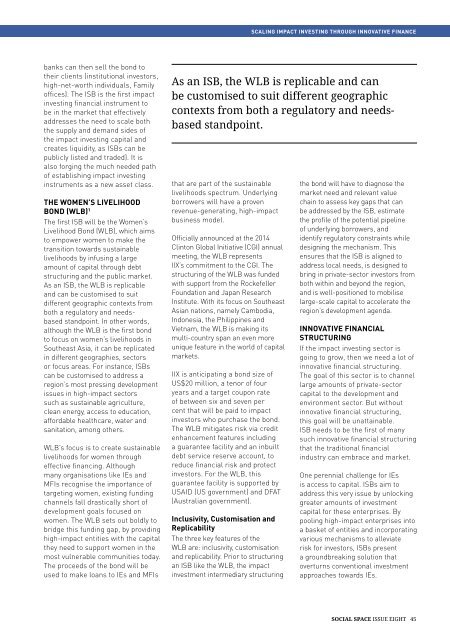Social Space (Issue 8, 2016-2017) - The Social Finance Issue
Since its debut in 2008, Social Space, the bi-annual flagship publication of the Lien Centre for Social Innovation at Singapore Management University, has provided a platform for local and international practitioners and thought leaders to share their perspectives on social innovation and entrepreneurship. Available in print and online (http://www.socialspacemag.org).
Since its debut in 2008, Social Space, the bi-annual flagship publication of the Lien Centre for Social Innovation at Singapore Management University, has provided a platform for local and international practitioners and thought leaders to share their perspectives on social innovation and entrepreneurship. Available in print and online (http://www.socialspacemag.org).
Create successful ePaper yourself
Turn your PDF publications into a flip-book with our unique Google optimized e-Paper software.
SCALING IMPACT INVESTING THROUGH INNOVATIVE FINANCE<br />
banks can then sell the bond to<br />
their clients (institutional investors,<br />
high-net-worth individuals, Family<br />
offices). <strong>The</strong> ISB is the first impact<br />
investing financial instrument to<br />
be in the market that effectively<br />
addresses the need to scale both<br />
the supply and demand sides of<br />
the impact investing capital and<br />
creates liquidity, as ISBs can be<br />
publicly listed and traded). It is<br />
also forging the much needed path<br />
of establishing impact investing<br />
instruments as a new asset class.<br />
<strong>The</strong> Women’s Livelihood<br />
Bond (WLB) 1<br />
<strong>The</strong> first ISB will be the Women’s<br />
Livelihood Bond (WLB), which aims<br />
to empower women to make the<br />
transition towards sustainable<br />
livelihoods by infusing a large<br />
amount of capital through debt<br />
structuring and the public market.<br />
As an ISB, the WLB is replicable<br />
and can be customised to suit<br />
different geographic contexts from<br />
both a regulatory and needsbased<br />
standpoint. In other words,<br />
although the WLB is the first bond<br />
to focus on women’s livelihoods in<br />
Southeast Asia, it can be replicated<br />
in different geographies, sectors<br />
or focus areas. For instance, ISBs<br />
can be customised to address a<br />
region’s most pressing development<br />
issues in high-impact sectors<br />
such as sustainable agriculture,<br />
clean energy, access to education,<br />
affordable healthcare, water and<br />
sanitation, among others.<br />
WLB’s focus is to create sustainable<br />
livelihoods for women through<br />
effective financing. Although<br />
many organisations like IEs and<br />
MFIs recognise the importance of<br />
targeting women, existing funding<br />
channels fall drastically short of<br />
development goals focused on<br />
women. <strong>The</strong> WLB sets out boldly to<br />
bridge this funding gap, by providing<br />
high-impact entities with the capital<br />
they need to support women in the<br />
most vulnerable communities today.<br />
<strong>The</strong> proceeds of the bond will be<br />
used to make loans to IEs and MFIs<br />
As an ISB, the WLB is replicable and can<br />
be customised to suit different geographic<br />
contexts from both a regulatory and needsbased<br />
standpoint.<br />
that are part of the sustainable<br />
livelihoods spectrum. Underlying<br />
borrowers will have a proven<br />
revenue-generating, high-impact<br />
business model.<br />
Officially announced at the 2014<br />
Clinton Global Initiative (CGI) annual<br />
meeting, the WLB represents<br />
IIX’s commitment to the CGI. <strong>The</strong><br />
structuring of the WLB was funded<br />
with support from the Rockefeller<br />
Foundation and Japan Research<br />
Institute. With its focus on Southeast<br />
Asian nations, namely Cambodia,<br />
Indonesia, the Philippines and<br />
Vietnam, the WLB is making its<br />
multi-country span an even more<br />
unique feature in the world of capital<br />
markets.<br />
IIX is anticipating a bond size of<br />
US$20 million, a tenor of four<br />
years and a target coupon rate<br />
of between six and seven per<br />
cent that will be paid to impact<br />
investors who purchase the bond.<br />
<strong>The</strong> WLB mitigates risk via credit<br />
enhancement features including<br />
a guarantee facility and an inbuilt<br />
debt service reserve account, to<br />
reduce financial risk and protect<br />
investors. For the WLB, this<br />
guarantee facility is supported by<br />
USAID (US government) and DFAT<br />
(Australian government).<br />
Inclusivity, Customisation and<br />
Replicability<br />
<strong>The</strong> three key features of the<br />
WLB are: inclusivity, customisation<br />
and replicability. Prior to structuring<br />
an ISB like the WLB, the impact<br />
investment intermediary structuring<br />
the bond will have to diagnose the<br />
market need and relevant value<br />
chain to assess key gaps that can<br />
be addressed by the ISB, estimate<br />
the profile of the potential pipeline<br />
of underlying borrowers, and<br />
identify regulatory constraints while<br />
designing the mechanism. This<br />
ensures that the ISB is aligned to<br />
address local needs, is designed to<br />
bring in private-sector investors from<br />
both within and beyond the region,<br />
and is well-positioned to mobilise<br />
large-scale capital to accelerate the<br />
region’s development agenda.<br />
Innovative Financial<br />
Structuring<br />
If the impact investing sector is<br />
going to grow, then we need a lot of<br />
innovative financial structuring.<br />
<strong>The</strong> goal of this sector is to channel<br />
large amounts of private-sector<br />
capital to the development and<br />
environment sector. But without<br />
innovative financial structuring,<br />
this goal will be unattainable.<br />
ISB needs to be the first of many<br />
such innovative financial structuring<br />
that the traditional financial<br />
industry can embrace and market.<br />
One perennial challenge for IEs<br />
is access to capital. ISBs aim to<br />
address this very issue by unlocking<br />
greater amounts of investment<br />
capital for these enterprises. By<br />
pooling high-impact enterprises into<br />
a basket of entities and incorporating<br />
various mechanisms to alleviate<br />
risk for investors, ISBs present<br />
a groundbreaking solution that<br />
overturns conventional investment<br />
approaches towards IEs.<br />
<strong>Social</strong> <strong>Space</strong> ISSUE EIGHT 45


